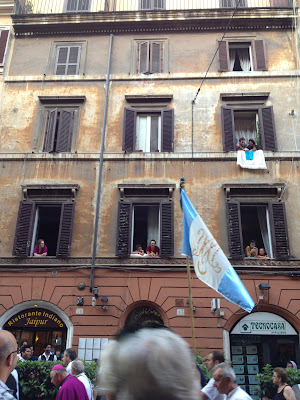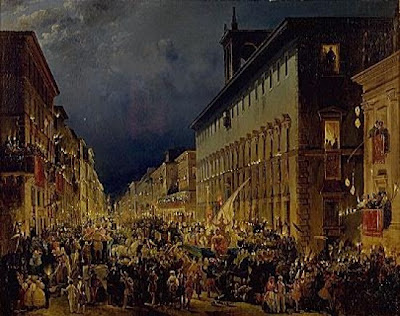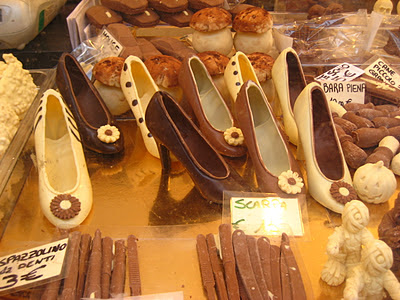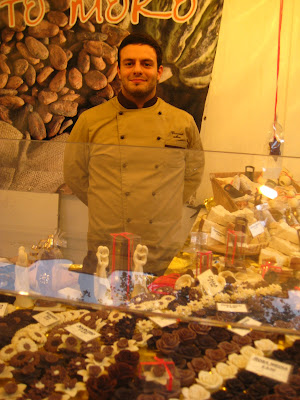 | ||||||||||||||||||||||||||||||||||||||||||||||||||||||||||||||||||||||||||||||||||||||||||||||||||||||||||||||||||||||
| Festa de' Noantri procession, 1950s [source] |
I remember that morning like it was yesterday: a bright mid-summer dawn, just weeks after moving into my dream Trastevere apartment. In a haze of grogginess and not enough sleep, I hear a booming, nasal voice. It's Sunday and seems impossibly early for whatever is happening, especially as it's happening right outside my bedroom window.
I bury my head in my pillow as I hear a monotone voice bleating out of a loudspeaker. Yes, a loudspeaker. A half-blind glance at my phone shows it’s not even 7am. "...Madre di Dio, prega per noi peccatori..."
Madre di Dio, what the...?
This I had to see. I flop out of bed and stumble over to the window. "Ave Maria, piena di grazia..." the voice drones on. Opening the shutters, I peer below.
 |
| Festa de' Noantri, Via Garibaldi, 2010, Crazy o'clock AM |
 |
| Festa de' Noantri, Via Garibaldi, 2010 |
 |
| Festa de' Noantri, Via Garibaldi, 2010 |
A procession, a full-on religious procession, was trundling past my window. There were priests, altar boys, a smattering of older ladies in somber dress. They were all doing a call-and-repeat version of the Ave Maria that I have since become much more familiar with. Oh, and they were carrying a gigantic statue of the Virgin Mary on their shoulders. One thing I have learned living in Italy is that Italians love the Virgin Mary. I mean, they love her more than Jesus. Or so it seemed to my then-non-Catholic self. I had almost literally stumbled upon the Festa de’ Noantri.
The pictures I've included here were not, of course, taken that morning, but four years later, when I was sadly packing up to leave that very same apartment and knew I was going to miss everything about it (besides the landlord). Little did I know then that my new apartment would be on the self-same procession route. It’s actually not so improbable; the Festa de’ Noantri procession goes down practically every street in Trastevere.
For a little bit of historical background (and a break from my nonsensical reminiscing), the festival dates back to 1535 when, after a storm, a cedar statue of the Madonna was fished out of the Tiber (on the Trastevere side, let it be noted!). Exactly where the statue came from is still a mystery, but where it ended up is not. It was donated to the order of the Carmelites, and hence it became known as the Madonna del Carmine (although many still refer to it as the Madonna della Fiumarola, since it was found in the river). The statue was kept in San Crisogono, an ancient church in Piazza Sonnino, and was immediately considered the protectress of the trasteverini. The statue was eventually transferred to the unassuming church of Sant’Agata, right across the square.
Every July, the first Saturday after the 16th to be precise, a major 8-day festival takes place in my beloved neighborhood to celebrate this “miraculous” statue (if you can consider a statue be fished out of a river a miracle). The original statue stays put in Sant’Agata (these days she’s too precious to move about), but a 19th-century polychrome wooden copy is carried about to much fanfare and jubilation (and yes, they change her outfit every year).
 |
| Festa de' Noantri, Pza San Francesco d'Assisi, 2012 |
 |
| Festa de' Noantri, Pza San Francesco d'Assisi, 2012 |
 |
| Festa de' Noantri, Via San Francesco a Ripa, 2012 |
After a goodly number of masses and benediction ceremonies, she is carried in solemn procession from Sant’Agata to the original statue’s first home, San Crisogono. But don’t think they just walk her across the square. That would be too easy. No, she is carried down Via della Lungaretta, Via della Luce and into Piazza San Francesco d’Assisi (where another celebration takes place), down Via San Francesco a Ripa, Via Natale del Grande, Via Roma Libera, and many more streets in Trastevere, until she is finally deposited at San Crisogono, where she stays for the duration of the festival.
 |
| Festa de' Noantri, Via San Francesco a Ripa, 2013 |
 |
| Festa de' Noantri, Via San Francesco a Ripa, 2013 |
 |
| Festa de' Noantri, Via San Francesco a Ripa, 2013 |
 |
| My friend Jill watching the procession from across the street |
Then the partying begins: street concerts of traditional music (cue: Roma,nun fa’ la stupida sta sera), old folks literally dancing in the streets, stall selling porchetta in Piazza Sonnino, bersaglieri playing their trumpets while they run (seriously impressive), and endless shouts of “Evviva Maria!” to be heard at any time of day or night. At the end of the festival, the pièce de resistance is when hundreds of people line the river or stand on the bridges to watch the Madonna float down the Tiber on a boat at sunset, from Ponte Sant’Angelo to Ponte Garibaldi.
 |
| Madonna della Fiumarola, Ponte Garibaldi, 2012 |
 |
| Madonna della Fiumarola, Isola Tiberina, 2012 |
So why is it called the Festa “de’ Noantri”? The word Noantri is a dialectical version of “noi altri” (us others). This was a way the residents of Trastevere voiced their indignation at the phrase, “voi altri che abitate in altri quartieri” (you others who live in other neighborhoods), with which they were referenced by the Roman populace. They were considered 2nd-class citizens because they lived on the wrong side of the
I feel very differently about the Festa de' Noantri these days, and that has less to do with the fact that I'm a Catholic convert (that's a story for another post), and more to do with the fact that the procession no longer wakes me up on Sunday mornings. It still passes under my bedroom window (although I now live in a different apartment on a different street), but it does so around 7 o’clock on Saturday night instead of 7 o’clock on Sunday morning, and that makes all the difference. In fact, I’ve come to love this festival. I’m now in my 8th year of witnessing it on my very street and it literally never gets old.
 |
| Festa de' Noantri, Piazza San Francesco d'Assini, 2012 |
If you happen to be in Trastevere tonight (Wed, 24 July 2013), get over to Piazza San Francesco d'Assini, stat! A brass band is playing as I write this, and who knows? Maybe the bersaglieri will show up with their fantastic feathered hats? I know I’ll be watching from my window.
Visit the festival's official site for a program of processions and events.
All photos (except first) by author.









































